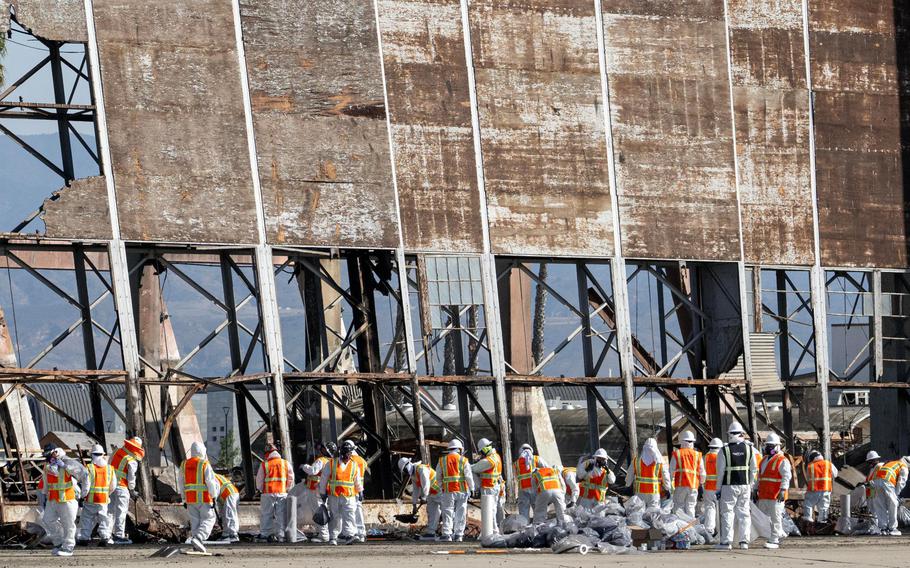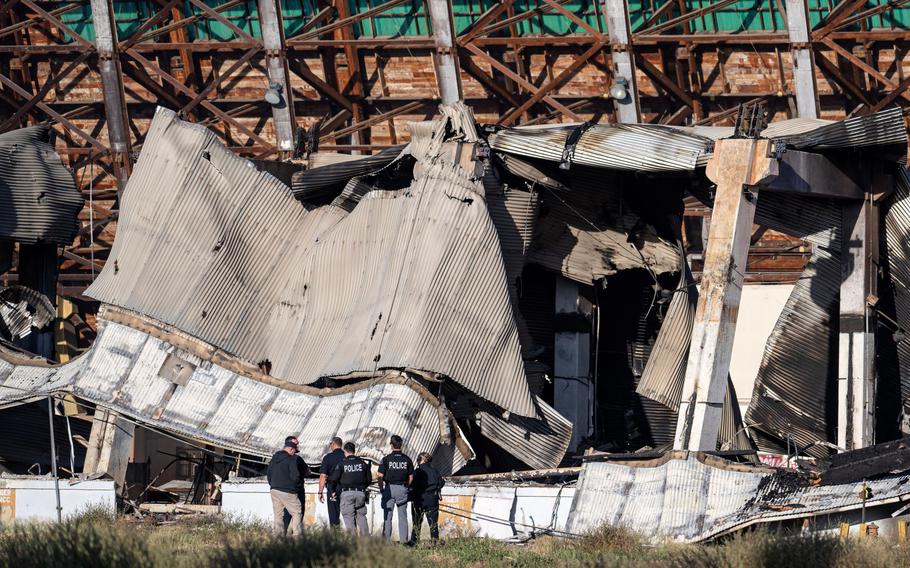
Workers in protective gear take part in hazardous waste clean up on Sunday, December 3, 2023 at the historic Marine Corps Air Station in Tustin. The hangar was destroyed in a fire last month. (Mindy Schauer, Orange County Register/SCNG)
Five weeks after a fire destroyed a 17-story World War II-era blimp hangar in Southern California, some local officials are concerned about the Navy’s pace of work and responsibility for the cost of the cleanup.
“There were a lot of promises made that we would have that support and it’s kind of dwindled as time has gone by,” Tustin City Councilwoman Letitia Clark said Dec. 5 during a meeting to call on the Navy to “double” its efforts.
One of two historic anti-submarine blimp hangars at former Marine Corps Air Station Tustin constructed in 1942 caught fire and partially collapsed Nov. 7 but continued to burn and smoke until completely extinguished Dec. 1. The Navy had closed the base in 1997.
Three days after the fire began, the Navy and local officials came to an agreement on Nov. 10 that gave local emergency officials wide leeway for any actions needed on the federal property. The Navy also pledged $1 million to cleanup efforts.
Since then, local officials have said the cost increased to clean up the fire, as well as testing and mitigating harm to neighborhoods, businesses and schools that have grown up around the hangars in the 80 years since they were built.

Officials investigate the rubble of the historic Tustin Marine Corps Air Station blimp hangar on Wednesday, November 8, 2023 after a fire destroyed the WWII-era structure. (Mindy Schauer, Orange County Register/SCNG)
Local officials said the price tag for the cleanup is already into the tens of millions of dollars and the Navy’s only publicly announced funding is insufficient.
Christopher Dunne, spokesman for the Naval Facilities Engineering Command in Washington, D.C., said Friday that the $1 million was only a down payment on the Navy’s help.
“The Navy has always known more than the money we already provided would be needed,” he said.
Dunne said no specific dollar figure has been determined at this point. What local officials might see as foot-dragging by the Navy is an attempt to follow federal rules that emphasize safety, thoroughness and caution.
“Sometimes the wheels of government turn slowly,” he said.
The complaints came as local contractors using a chemical adhesive nicknamed “gorilla snot” to hold the panels in place began to bring the heavy metal doors at either end of the 1,000-foot-long hangars slowly to the ground. High winds stalled the effort over the weekend, but plans were to complete the process within about two weeks.
“During this slow and controlled process, all six panels will be lowered to the ground,” the City of Tustin said on its webpage dedicated to the hangar fire and demolition. “All door materials will remain onsite, and no removal will take place during this time.”
At that point, all that will remain of the north hangar will be the concrete frame for the doors, standing like obelisks alone against the sky. The panels will be left on the ground for the Navy to do the final demolition work on the concrete, metal and burned-wood remnants.
The city promised residents that it would monitor the work “until the hangar site has been completely remediated by the U.S. Navy.”
Beyond additional money that might go to local governments, the Navy will foot the bill and contract the work to “deconstruct” — essentially a meticulous demolition — the remaining wreckage and haul away the debris, while ensuring the area left behind is not a danger to local health.
“That’s the Navy’s responsibility,” Dunne said.
Details of a contract for the work are still pending.
Residents and local officials want more information on what the Navy plans to do about the fire’s toxic footprint beyond the federal land and whether the service will pay for the cost of inspecting and mitigating contamination on properties hundreds of yards or even miles away from the hangar.
The city has received 1,029 reports of fire debris to its hangar response portal, of which 973 have been inspected and 806 have been mitigated and cleared.
The city reported Monday that all 29 schools in the Tustin Unified School District have been inspected, mitigated and cleared. Two schools closest to the hangar fire remained closed until a final all-clear is given by local and state environmental experts.
Legacy Park, closest to the hangar, remains the last of 11 city parks to reopen following inspections and clean-up.
The hangars have been a local historic landmark — one of the local schools had its roof line designed to echo the airships’ home.
Now that the north hangar is destroyed, there is a desire to see the eyesore beside the busy Interstate 5 removed swiftly.
“That may be the Navy’s property, but this here is the city,” Tustin Mayor Austin Lumbard told a group of reporters last week.